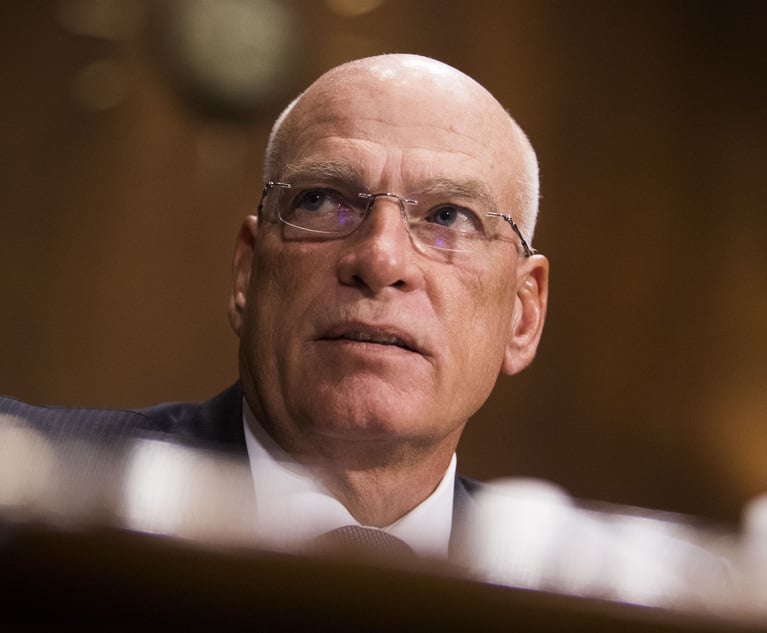A Stitch in Time Saves Nine: Sustainable Compliance in Cyberspace
In the not-so-distant past, when hackers breached a company's cybersecurity defenses and pilfered data, including sensitive customer information, the government and public alike often viewed the company as one of the victims.
March 09, 2018 at 12:20 PM
7 minute read

In the not-so-distant past, when hackers breached a company's cybersecurity defenses and pilfered data, including sensitive customer information, the government and public alike often viewed the company as one of the victims. Not anymore. A confluence of cybersecurity developments is changing the game: highly publicized corporate network intrusions impacting large swaths of the U.S. population (Equifax, Yahoo and Target, to name just a few); a wave of aggressive new regulations (both currently in effect and proposed) at the state and federal levels, with the looming threat of regulatory enforcement and sizable penalties; and growing exposure to legal liability for data breaches under existing consumer protection laws. As the dust settles, an emerging legal and regulatory standard of care for cybersecurity is coming into sharper focus. Global financial firms, in particular, should pay close attention to this quickly evolving cybersecurity compliance landscape—or risk getting crushed under the weight of stiffening regulations and class action lawsuits.
|Cybersecurity Regulations On the Rise
State and federal government agencies are increasingly pushing to regulate cybersecurity compliance, especially for financial services companies that routinely handle sensitive customer information. Cybersecurity has long been a mostly unregulated affair: stakeholders have operated pursuant to industry best practices and voluntary guidelines, such as the National Institute of Standards and Technology's “Framework for Improving Critical Infrastructure Cybersecurity.” In March 2017, though, New York state's financial watchdog, the Department of Financial Services (DFS), issued cybersecurity requirements for financial services companies. This is the first such set of regulations at the state level and easily the most ambitious cybersecurity compliance regime to date. Codified in Section 500 of the New York Code of Rules and Regulations, the suite of regulations applies to any corporation with more than 10 employees subject to New York's Banking Law, Insurance Law, or Financial Services Law (with some exemptions). “Section 500,” as it's simply known, mandates that covered companies, among other things:
- Designate a chief information security officer who is responsible for overseeing and enforcing the company's cybersecurity policy;
- Create a cybersecurity program that includes monitoring and testing, developed in accordance with the company's cybersecurity risk assessment; and
- Implement and maintain written policies addressing 14 areas, including information security, data governance and classification, and customer data privacy.
DFS is not alone. In September 2016, shortly after DFS proposed the original iteration of the above regulations, three federal bank regulators—the Board of Governors of the Federal Reserve System, the Office of the Comptroller of the Currency, and the Federal Deposit Insurance Corp.—issued a joint notice of proposed rulemaking. These proposed rules (the comment period ended in February 2017) would convert historically voluntary standards for cybersecurity controls into federal regulations, requiring implementation of enhanced standards in the five following areas:
- Cyberrisk governance;
- Cyberrisk management;
- Internal dependency management;
- External dependency management and incident response; and
- Cyberresilience and situational awareness.
Moreover, as recently as January 2018, Sens. Elizabeth Warren and Mark Warner introduced a bill that would provide the Federal Trade Commission with punitive powers that match the enormity of a firm's data breach. The proposed law would set potential fines for breaches at a base penalty of $100 for each consumer with one piece of personal identifying information stolen, plus $50 for each additional piece of personal identifying information compromised per consumer. Under current law, consumer awards for stolen personal data are normally in the range of only $1 to $2.
|Mounting Legal Exposure
Risk of legal liability for cyber intrusions is ballooning as well. In the federal courts, plaintiffs are making headway in holding companies financially accountable for data breaches that compromised sensitive customer information. In particular, litigants are finding it easier to gain standing, with appellate courts showing greater concern for consumer interests in this area.
“Standing” is a threshold hurdle for all civil litigants: a plaintiff must demonstrate, in essence, that the alleged wrongdoing led to an actual injury. Historically, establishing standing for a cause of action arising from a data breach has been challenging. That is because “injuries” in this context are often future injuries, such as prospective damage to a consumer's credit score or the risk of identity theft at some future point in time.
But the legal tide began to turn in 2015. The case involved a class action against Neiman Marcus by a group of customers whose credit card information had been hacked. The plaintiffs alleged standing based on two “future” injuries: increased risk of future fraudulent charges and greater susceptibility to identity theft. Notwithstanding their speculative nature, the U.S. Court of Appeals for the Seventh Circuit sided with the plaintiffs in concluding that these injuries were sufficiently imminent to create standing. In a subsequent class action against the insurer Nationwide for a large data breach, the Sixth Circuit followed suit in reversing the district court's dismissal for lack of standing, reasoning that the plaintiffs had established an adequate risk of future fraud and identity theft. Next, in January 2017, the Third Circuit held that certain data breach incidents alleging violations of federal statutes provided standing—even if the plaintiff did not allege tangible, personal harm arising from the breach. And in August 2017, the D.C. Circuit widened the circuit split, overturning a district court's dismissal of a complaint for lack of standing in a data breach case. These decisions are greasing the wheels for similar class actions going forward.
The infamous Equifax data breach will further clarify the state of the law. As widely reported several months ago, Equifax announced an unprecedented infiltration of its network that compromised the sensitive personal identifying information of more than 143 million people. In the wake of the breach, media and public sentiment have not looked kindly on Equifax. But the firm's challenges go beyond just reputational: two proposed class actions have already been filed in different federal courts that claim the company's negligent failure to protect consumer data. Plaintiffs' attorneys say the class could seek up to $70 billion in nationwide damages, and Equifax stock has plummeted. As of November 2017, consumers had filed more than 240 total class action lawsuits against the company in federal, state, and Canadian courts. Whether U.S. courts will find that the Equifax plaintiffs carry standing remains to be seen, although the momentum seems to be on their side.
|Cybersecurity Crossroads
As this drumbeat of legal and regulatory change shows, cybersecurity compliance is approaching an inflection point—not unlike the rapid growth and prioritization of financial crime compliance nearly two decades ago. Absent preparation and proactivity in the near term, including making informed decisions about how to build a sustainable, technology-enabled compliance program to meet these new challenges, companies will find themselves late to the game, struggling to catch up, and vulnerable to unmitigated risk of every stripe. Instead, firms should take the opportunity to be at the forefront of the cybersecurity movement. This begins with the basics: performing an enterprise-wide risk assessment to take stock of a company's cybersecurity risks and controls, and then using that risk assessment as the foundation for remediating any gaps. Firms that act fast and get ahead of the curve will be thankful that they did.
N. David Neeman is an attorney and independent consultant.
Timothy C. Stone is a director in the New York office of Exiger, the global compliance firm.
This content has been archived. It is available through our partners, LexisNexis® and Bloomberg Law.
To view this content, please continue to their sites.
Not a Lexis Subscriber?
Subscribe Now
Not a Bloomberg Law Subscriber?
Subscribe Now
NOT FOR REPRINT
© 2025 ALM Global, LLC, All Rights Reserved. Request academic re-use from www.copyright.com. All other uses, submit a request to [email protected]. For more information visit Asset & Logo Licensing.
You Might Like
View All
Class Certification, Cash-Sweep Cases Among Securities Litigation Trends to Watch in 2025
6 minute read
'Serious Disruptions'?: Federal Courts Brace for Government Shutdown Threat
3 minute read
'Unlawful Release'?: Judge Grants Preliminary Injunction in NASCAR Antitrust Lawsuit
3 minute read
Baker Botts' Biopharma Client Sues Former In-House Attorney, Others Alleging Extortion Scheme
Trending Stories
- 1Restoring Trust in the Courts Starts in New York
- 2'Pull Back the Curtain': Ex-NFL Players Seek Discovery in Lawsuit Over League's Disability Plan
- 3Tensions Run High at Final Hearing Before Manhattan Congestion Pricing Takes Effect
- 4Improper Removal to Fed. Court Leads to $100K Bill for Blue Cross Blue Shield
- 5Michael Halpern, Beloved Key West Attorney, Dies at 72
Who Got The Work
Michael G. Bongiorno, Andrew Scott Dulberg and Elizabeth E. Driscoll from Wilmer Cutler Pickering Hale and Dorr have stepped in to represent Symbotic Inc., an A.I.-enabled technology platform that focuses on increasing supply chain efficiency, and other defendants in a pending shareholder derivative lawsuit. The case, filed Oct. 2 in Massachusetts District Court by the Brown Law Firm on behalf of Stephen Austen, accuses certain officers and directors of misleading investors in regard to Symbotic's potential for margin growth by failing to disclose that the company was not equipped to timely deploy its systems or manage expenses through project delays. The case, assigned to U.S. District Judge Nathaniel M. Gorton, is 1:24-cv-12522, Austen v. Cohen et al.
Who Got The Work
Edmund Polubinski and Marie Killmond of Davis Polk & Wardwell have entered appearances for data platform software development company MongoDB and other defendants in a pending shareholder derivative lawsuit. The action, filed Oct. 7 in New York Southern District Court by the Brown Law Firm, accuses the company's directors and/or officers of falsely expressing confidence in the company’s restructuring of its sales incentive plan and downplaying the severity of decreases in its upfront commitments. The case is 1:24-cv-07594, Roy v. Ittycheria et al.
Who Got The Work
Amy O. Bruchs and Kurt F. Ellison of Michael Best & Friedrich have entered appearances for Epic Systems Corp. in a pending employment discrimination lawsuit. The suit was filed Sept. 7 in Wisconsin Western District Court by Levine Eisberner LLC and Siri & Glimstad on behalf of a project manager who claims that he was wrongfully terminated after applying for a religious exemption to the defendant's COVID-19 vaccine mandate. The case, assigned to U.S. Magistrate Judge Anita Marie Boor, is 3:24-cv-00630, Secker, Nathan v. Epic Systems Corporation.
Who Got The Work
David X. Sullivan, Thomas J. Finn and Gregory A. Hall from McCarter & English have entered appearances for Sunrun Installation Services in a pending civil rights lawsuit. The complaint was filed Sept. 4 in Connecticut District Court by attorney Robert M. Berke on behalf of former employee George Edward Steins, who was arrested and charged with employing an unregistered home improvement salesperson. The complaint alleges that had Sunrun informed the Connecticut Department of Consumer Protection that the plaintiff's employment had ended in 2017 and that he no longer held Sunrun's home improvement contractor license, he would not have been hit with charges, which were dismissed in May 2024. The case, assigned to U.S. District Judge Jeffrey A. Meyer, is 3:24-cv-01423, Steins v. Sunrun, Inc. et al.
Who Got The Work
Greenberg Traurig shareholder Joshua L. Raskin has entered an appearance for boohoo.com UK Ltd. in a pending patent infringement lawsuit. The suit, filed Sept. 3 in Texas Eastern District Court by Rozier Hardt McDonough on behalf of Alto Dynamics, asserts five patents related to an online shopping platform. The case, assigned to U.S. District Judge Rodney Gilstrap, is 2:24-cv-00719, Alto Dynamics, LLC v. boohoo.com UK Limited.
Featured Firms
Law Offices of Gary Martin Hays & Associates, P.C.
(470) 294-1674
Law Offices of Mark E. Salomone
(857) 444-6468
Smith & Hassler
(713) 739-1250






